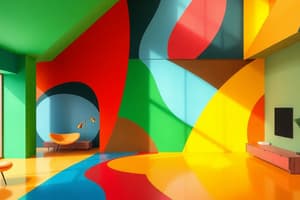Podcast
Questions and Answers
ما هي الأسباب الرئيسية لدراسة تاريخ العمارة؟
ما هي الأسباب الرئيسية لدراسة تاريخ العمارة؟
توفر فهمًا عميقًا للتطورات الهندسية والثقافية والاجتماعية التي أثرت على تصميم المباني عبر العصور. وتوفر فهمًا للأساليب والتقنيات، والتراث الثقافي، واستلهام الأفكار
ما هي أهمية دراسة تاريخ العمارة؟
ما هي أهمية دراسة تاريخ العمارة؟
- التعرف على التراث الثقافي
- فهم الأساليب والتقنيات
- استلهام الأفكار
- كل ما سبق (correct)
ما الفرق بين الاتجاه والحركة والأسلوب والمدرسة في التصميم الداخلي؟
ما الفرق بين الاتجاه والحركة والأسلوب والمدرسة في التصميم الداخلي؟
- ينعكس في اختلاف مدة استمرارية كل مصطلح
- كل ما سبق (correct)
- كل مصطلح يعكس مستوى معينًا من التأثير على التصميم، سواء كان تأثيرًا قصير المدى أو طويل المدى
- الاتجاه مؤقت بينما الأسلوب ثابت
ما المميزات الرئيسية للمدارس المعمارية المقترحة في هذه العروض؟
ما المميزات الرئيسية للمدارس المعمارية المقترحة في هذه العروض؟
ما الذي تُعنى به مبادئ التصميم الداخلي؟
ما الذي تُعنى به مبادئ التصميم الداخلي؟
ما هو سبب أهمية دراسة تاريخ العمارة؟
ما هو سبب أهمية دراسة تاريخ العمارة؟
ما هي المميزات الرئيسية للمدارس المعمارية
ما هي المميزات الرئيسية للمدارس المعمارية
يؤثر التطور التقني والابتكار على تصميم المباني؟
يؤثر التطور التقني والابتكار على تصميم المباني؟
ما هو الفرق بين الاتجاه والحركة والأسلوب والمدرسة في التصميم الداخلي؟
ما هو الفرق بين الاتجاه والحركة والأسلوب والمدرسة في التصميم الداخلي؟
Flashcards
تاريخ العمارة
تاريخ العمارة
دراسة التطورات الهندسية والثقافية والاجتماعية التي أثرت على تصميم المباني عبر العصور.
اتجاه
اتجاه
ميل مؤقت وشائع في التصميم يتغير مع الزمن.
أسلوب
أسلوب
طريقة ثابتة ومميزة في التصميم تستند إلى خصائص معينة وتستمر لفترة أطول.
حركة
حركة
Signup and view all the flashcards
مدرسة
مدرسة
Signup and view all the flashcards
مدارس معمارية
مدارس معمارية
Signup and view all the flashcards
االرتباط بالتاريخ والتراث الثقافي
االرتباط بالتاريخ والتراث الثقافي
Signup and view all the flashcards
التركيز على الجمال والفن
التركيز على الجمال والفن
Signup and view all the flashcards
اتجاه
اتجاه
Signup and view all the flashcards
أسلوب
أسلوب
Signup and view all the flashcards
حركة
حركة
Signup and view all the flashcards
مدرسة
مدرسة
Signup and view all the flashcards
مدارس معمارية
مدارس معمارية
Signup and view all the flashcards
االرتباط بالتاريخ والتراث الثقافي
االرتباط بالتاريخ والتراث الثقافي
Signup and view all the flashcards
التركيز على الجمال والفن
التركيز على الجمال والفن
Signup and view all the flashcards
تاريخ العمارة
تاريخ العمارة
Signup and view all the flashcards
لماذا يُدرس تاريخ العمارة؟
لماذا يُدرس تاريخ العمارة؟
Signup and view all the flashcards
Study Notes
Recent Trends in Interior Design
- Interior design trends are influenced by engineering, cultural, and social developments.
- Studying the history of architecture is important because it provides a deep understanding of these influences.
Why Study Architecture History?
- Understanding methods and techniques
- Learning about cultural heritage
- Inspiring ideas
- Influencing future designs
- Preserving heritage
- Analyzing social and political life
Differences in Design Terms
- Trend: A temporary and common design that changes over time.
- Style: A fixed and distinct design way based on specific characteristics, lasting for a longer time.
- Movement: A comprehensive change in arts and design caused by social or intellectual transformations.
- School: A philosophy or academic approach embraced by a group of designers, having a long-term impact.
Different Artistic Trends and Schools
- Architectural schools reflect artistic and intellectual currents in design over time.
- Features of architectural schools vary according to the artistic and intellectual current they represent.
Main Features of Architectural Schools
- Connection to history and cultural heritage: Some schools draw inspiration from the cultural heritage of different peoples, giving buildings a historical depth.
- Focus on beauty and art: Some schools are interested in decorative, aesthetic design, and add innovative artistic touches.
- Functionalism: Some schools focus on the practical function of buildings, seeking high levels of sustainability and efficiency.
- Technical development and innovation: Some schools utilize modern technology and new architectural developments in design.
- Openness to the world: Some schools focus on creating international buildings expressing the diverse cultures of the world.
- Attention to harmony and balance: Some schools focus on creating balance and harmony between the technical and functional aspects of buildings.
Principles of Interior Design
- Balance: Creating visual equilibrium in the space.
- Unity: A sense of cohesion among the elements.
- Rhythm: A pattern of repetition in design elements.
- Scale and Proportion: The visual relationship between the size of elements and the space.
- Contrast: Creating visual interest by using different elements
- Emphasis: Focusing attention on specific areas or characteristics.
- Details: Paying attention to the smaller elements and details.
Studying That Suits You
Use AI to generate personalized quizzes and flashcards to suit your learning preferences.




